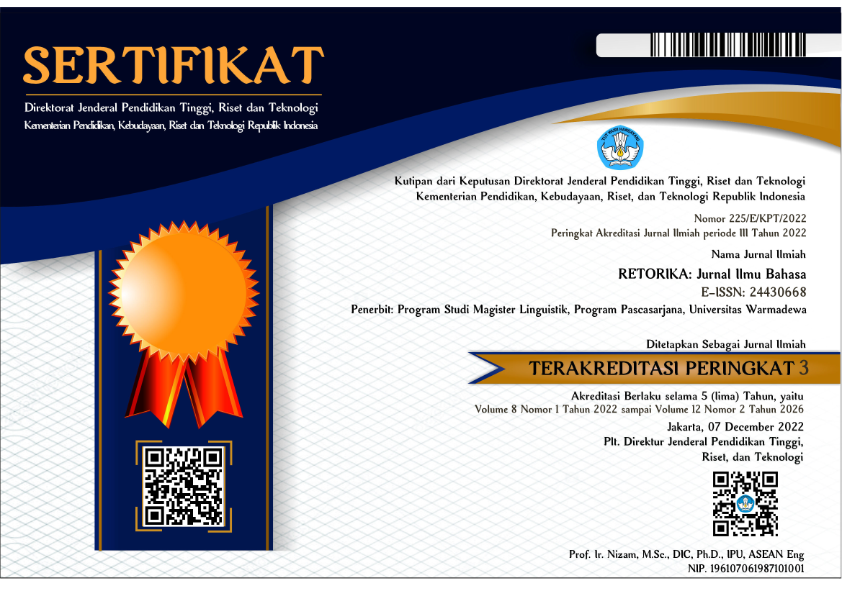The Communicativeness and Critical Thinking Devices of Language Supplementary Materials for Primary School
Piranti Berpikir Kritis dan Komunikatif Materi Penunjang Kebahasaan di Sekolah Dasar
Abstract
Studies show that teaching materials can be integrated with critical thinking skills for enhancing successful learning. However, the integration is not always clear as the communicativeness aspect of the materials also contributes to the goal of effective learning. This study focuses on critical thinking devices and the aspect of communicativeness fulfilled or violated in Indonesian primary school supplementary materials for language courses. It employs content or document analysis on the supplementary materials of the first graders on courses of English, Indonesian and Javanese languages. The analysis is based on the assumption that critical thinking tools and communicative aspects are the two main pillars that characterize the quality of language teaching materials in elementary schools. In addition, critical thinking tools are linked with communicative aspects of language teaching materials to target targeted competency standards. The results show that the communicativeness aspect is supported by the use of real context and authenticity of the materials. In terms of critical thinking device, the supplementary materials are supported by clear purpose in presenting key information. The evaluation on the supplementary materials concerns with the effort to improve the quality of primary school student’s cognitive attainment and critical thinking through communicative supplementary materials.
References
Akbari, O., & Razavi, A. (2015). Using authentic materials in the foreign language classrooms: Teachers’ perspectives in EFL classes. International Journal of Research Studies in Education, 4(5).
Cunningsworth, A. (1995). Choosing Your Coursebook.
Derewianka, B. M., & Jones, P. T. (2016). Teaching Language in Context.
Ernst, J. (Athman), & Monroe, M. (2006). The Effects of Environmentâ€Based Education on Students’ Critical Thinking Skills and Disposition toward Critical Thinking. Environmental Education Research, 12(3–4), 429–443.
Gilakjani, A. P., & Sabouri, N. B. (2016). A Study of Factors Affecting EFL Learners’ Reading Comprehension Skill and the Strategies for Improvement. International Journal of English Linguistics, 6(5), 180.
Hadfield, J. (1989). Reviews: Making the Most of Your Textbook (Neville Grant Longman 1987). ELT Journal, 43(2), 158–159.
Harmer, J. (2007). How to Teach English.
Hill, F., Bordes, A., Chopra, S., & Weston, J. (2015). The Goldilocks Principle: Reading Children’s Books with Explicit Memory Representations.
Hofreiter, T. D., Monroe, M. C., & Stein, T. V. (2007). Teaching and Evaluating Critical Thinking in an Environmental Context. Applied Environmental Education & Communication, 6(2), 149–157.
Hudson, A. K., & Williams, J. A. (2015). Reading Every Single Day: A Journey to Authentic Reading. The Reading Teacher, 68(7), 530–538.
Huettig, F., & Mani, N. (2016). Is Prediction Necessary to Understand Language? Probably not. Language, Cognition and Neuroscience, 31(1), 19–31.
Indah, R. N. (2010). Discovering Student’s Expertise to Augment Claim Quality in Writing Class at UIN Maliki Malang.
Indah, R. N. (2012). Communicating Critical Thinking through Bilingual Reflective Writing.
Indah, R. N. (2013). Reformulating Reading Materials to Foster Student’s Critical Thinking.
Indah, R. N. (2014). Stabilized Errors: Attributed Problem in Timed and Non-Timed Argumentative Writing. LiNGUA: Jurnal Ilmu Bahasa Dan Sastra, 9(2).
Indah, R. N. (2017). Critical Thinking, Writing Performance and Topic Familiarity of Indonesian EFL Learners. Journal of Language Teaching and Research, 8(2), 229.
Kemendikbud. (2013). Kompetensi Dasar SD/MI.
Kemendikbud. (2017). Panduan Penilaian oleh Pendidik dan Satuan Pendidikan untuk Sekolah Menengah Atas.
Maghfiroh, M. L. (2011). The quality of student book "Bahasa Inggris for Junior High School Year VIII (Universitas Negeri Malang).
Maryani, I., & Martaningsih, S. T. (2015). Correlation between Teacher’s PCK (Pedagogical Content Knowledge) and Student’s Motivation in Primary School in Indonesia. International Journal of Evaluation and Research in Education (IJERE), 4(1), 38.
Nurcahyo, T. W., & Rachmajanti, S. (2013). A Review on English Workbook “Excellent†Used by 12th Graders at SMAN 1 Lawang (Universitas Negeri Malang).
Paul, R., & Elder, L. (2012). The International Critical Thinking Reading and Writing Test.
Riasati, M. J., & Zare, P. (2010). Textbook Evaluation: EFL Teachers’ Perspectives on “New Interchange.†Studies in Literature and Language, 1(8).
Riaz, A. M., & Mosalanejad, N. (2010). Evaluation of Learning Objectives in Iranian High-School and Pre-University English Textbooks Using Bloom’s Taxonomy. TESL-EJ, 13(4).
Richard, J. C. (2006). Communicative Language Teaching Today.
Sheldon, L. E. (1988). Evaluating ELT Textbooks and Materials. ELT Journal, 42(4), 237–246.
Silva, M., & Cain, K. (2015). The Relations between Lower and Higher Level Comprehension Skills and Their Role in Prediction of Early Reading Comprehension. Journal of Educational Psychology, 107(2), 321–331.
Thamrin, N. R., & Agustin, S. (2019). Conceptual Variations on Reading Comprehension through Higher Order Thinking Skills (HOTS) Strategy. English Review: Journal of English Education, 7(2), 93.
Wade, C. (1995). Using Writing to Develop and Assess Critical Thinking. Teaching of Psychology, 22(1), 24–28.
Wasik, B. A., Hindman, A. H., & Snell, E. K. (2016). Book Reading and Vocabulary Development: A Systematic Review. Early Childhood Research Quarterly, 37, 39–57.
Copyright (c) 2020 RETORIKA: Jurnal Ilmu Bahasa

This work is licensed under a Creative Commons Attribution-ShareAlike 4.0 International License.
This journal provides immediate open access to its content on the principle that making research freely available to the public supports a greater global exchange of knowledge.
All articles published Open Access will be immediately and permanently free for everyone to read and download. We are continuously working with our author communities to select the best choice of license options, currently being defined for this journal as follows: Creative Commons-Non Ceomercial-Attribution-ShareAlike (CC BY-NC-SA)
 Abstract viewed = 341 times
Abstract viewed = 341 times
 PDF downloaded = 257 times
PDF downloaded = 257 times

2.png)














